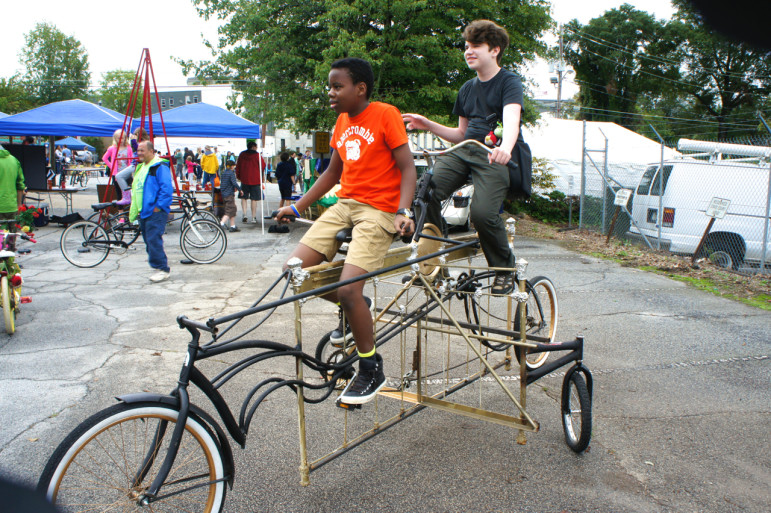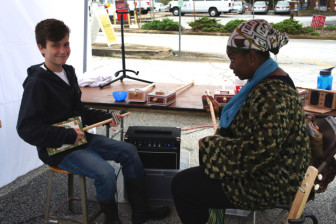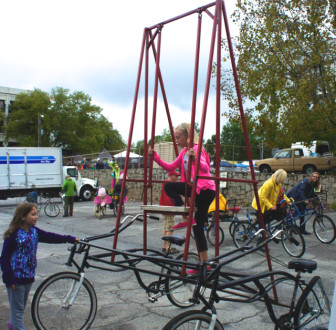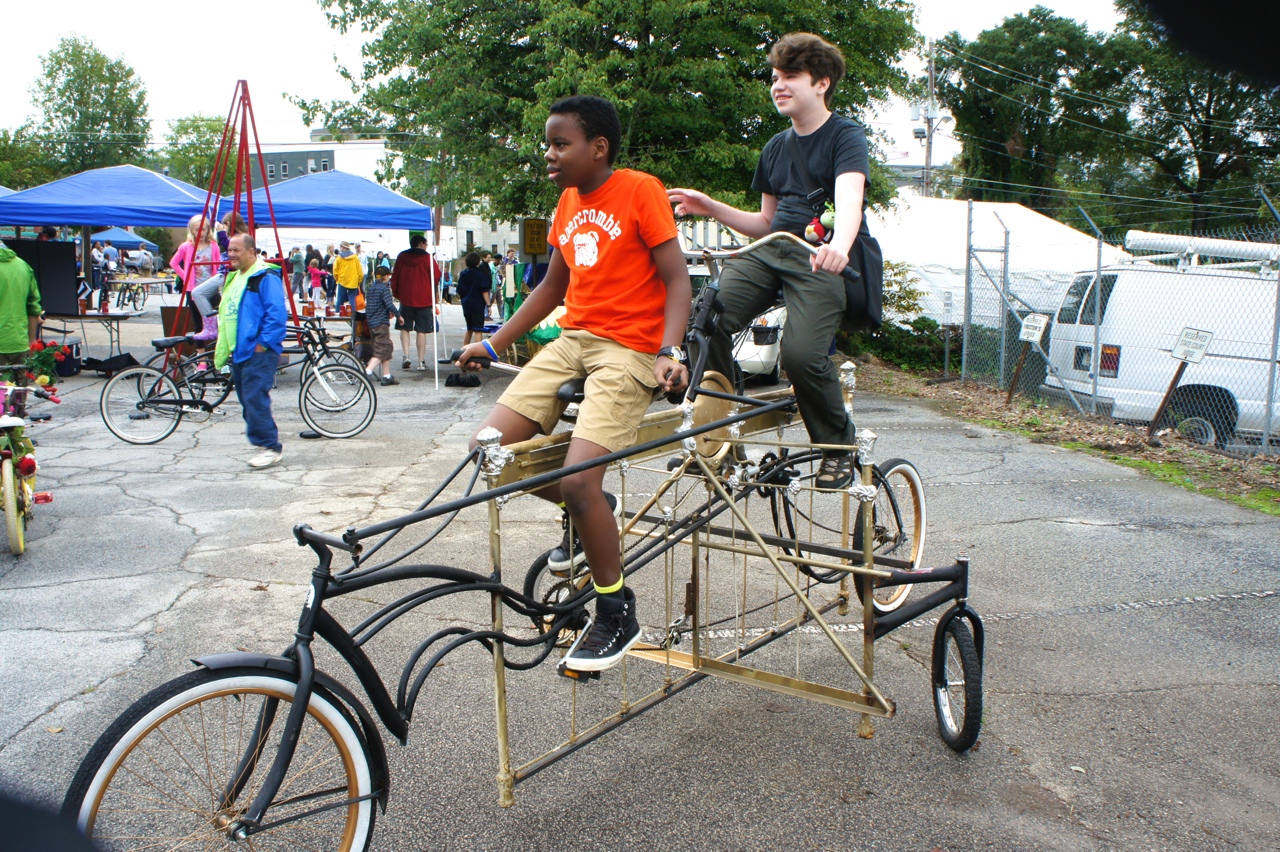
Photo by Stell Simonton
Kids in the Urban Art Bike program at Art 120 in Chattanooga design and create unusual bikes.
“Do you want to try this?” asks 11th-grader Gabi Urschel, as she stands inside a booth labeled “Alan Likes Science.”
It’s a gray drizzly day, but throngs of people are moving from booth to booth along McDonough Street in the Decatur suburb of Atlanta.
In Gabi’s booth, two metal plates are linked by a voltmeter. She encourages a boy to see how much electric current he can generate just by putting a hand on each plate.
Nearby is a booth with even more activity. On the pavement behind it, kids are riding elaborately tricked-out bikes. A girl sways on a high swing mounted on two black bike frames. A boy circles around on a silver bike with wings.
The bikes were made by the kids of Art 120, a Chattanooga, Tennessee, youth-development program. They’ve come to Maker Faire Atlanta, a combination street festival and science fair where “makers” of all ages and kinds show their stuff.
Maker Faires, which began in the San Francisco Bay Area in 2006, have spread around the country and overseas. This year, they are expected to draw a total of 1 million people, according to the business technology magazine Fast Company.
The fairs are part of the burgeoning “maker movement,” a surge of do-it-yourself activity growing out of the tech industry.
The movement is bringing new energy to school and out-of-school science programs.
And Kate Warren, the founder of Art 120, is on board.
Her organization, which serves kids in a 120-mile radius around Chattanooga, started the Urban Art Bike summer program. Kids ages 11 to 15 work in teams of four to come up with wild ideas for embellishing bicycles. Working with an adult, they have 40 hours to generate, develop and build their design.
They learn welding and some math and physics, Warren said.
“It’s incredibly inspiring to see them realize they can take an idea out of their head” and — with proper planning and assistance — build it, she said. “They light up.”
‘Yes, you can’
Warren’s husband, Lee Warren, brought the kids to Maker Faire Atlanta in October.
“Kids are always being told ‘no, you can’t,’” he said. “We’re saying ‘yes, you can.’”
Adults help the kids brainstorm.
“You want to make a swing on a bike?” the adult might respond.“How do you do that?”
In the process of design, kids present their ideas to the larger group. They’re learning teamwork and public speaking, Lee Warren said.
The skill of welding is extremely important, too, Kate Warren said. It’s a skill that can lead directly to a job.

Photo by Stell Simonton
Patrick Wright, 14, makes guitars from cigar boxes. Here, he plays music with a visitor to his booth at Maker Faire Atlanta.
Forty-two kids have come through Art 120’s Urban Art Bike program, which has also brought 39 artists to Chattanooga elementary schools — many of which would otherwise not offer art — reaching 14,627 kids, Warren said.
The maker movement and out-of-school time programs are natural allies, according to the National Afterschool Association. They both focus on hands-on, experiential learning.
The Afterschool Alliance has presented webinars on the movement and sees it as a valuable way to teach science, technology, engineering and math in out-of-school time. One webinar discussed how to ensure equity for girls and minorities.
The movement initially was inspired by new technology coming out of Silicon Valley. But it’s not just about technology and 3-D printers, Warren said.
It could be cooking or custom-embellishing furniture, among other things, she said.
“It’s about using your own hands to create,” she said.
At Art 120, it’s also about having an idea and not being afraid to share it. Team members pick up the idea and extend it.
“There’s a lot of camaraderie,” she said.
“It seems to really give kids something they can’t get from being in front of a TV or computer all day,” she said.
Making it all up
The term “maker” was coined by technology writer Dale Dougherty, who started Make: magazine in 2005. He pitched his magazine to an investor as a “Martha Stewart for geeks.” A year later, the magazine organized the first Maker Faire to bring together its readers and other techies and tinkerers. The gathering drew 22,000 people.
The movement now includes businesses, online platforms and educational efforts as well as all the do-it-yourselfers.
Some adherents have been accused of making grandiose claims, such as describing the movement as a third industrial revolution.

Photo by Stell Simonton
A girl climbs onto a swing at the top of two bicycles. The structure was created by kids in the youth development program Art 120.
“Just who are these people?” asked the New Yorker in an article last year. It criticized one assertion that the individual manufacturing of makers will undermine the power of large corporations.
And the excitement about “making” as a new activity can also look a little silly, since toolmaking has been around since hominids first picked up sticks and Homo sapiens chipped stone blades.
What the maker movement does, however, is connect the impulses of DIY technologists with people who do woodworking or sewing or a myriad other crafts. And its enormous growth is clearly meeting an appetite.
Make: magazine is published by Maker Media, which runs the fairs and operates businesses that have grown from the movement. Maker Media founder Dale Dougherty started the nonprofit Maker Ed in 2012 to support educators and communities create “making and learning experiences” with young people, especially kids in underserved areas.
In addition to providing funding for educational projects, Maker Ed sends VISTA volunteers to help various organizations set up “maker spaces.”
Libraries, museums, schools and youth organizations are among those setting up such spaces.
Creating spaces
For example, the Madison Public Library in Madison, Wisconsin, offers hands-on workshops in a ground-floor room called the Bubbler Room. Local experts come to teach computer animation, screen printing, music and clothing design. The library also has a media lab where the public can explore digital media production, including audio engineering, game design and animation.
Museums such as the New York Hall of Science in Queens, New York, a hands-on science and technology museum, offers workshops for families and young kids to tinker with various materials to explore science phenomena. Considered a maker space, this program has allowed children to make soap, explore how birds make nests and learn the science behind “superhero powers.”
In 2014 the information technology company Cognizant awarded 33 grants to after-school, in-school and summer programs to run hands-on, maker-movement inspired programs. Grantees included Girls Inc., 4-H and GirlStart, a summer and after-school program for girls.
The information technology company is taking applications for 2015 grants until Sunday.
Teens at work and play
At Maker Faire Atlanta, Gabi, who set up the booth with her father, Alan, explained the science behind her experiment. When you put one hand on a copper plate and another on an aluminum plate, the film of sweat on your hands acts like battery acid, she told the kids who stopped by. A small current flows from hand to hand because of the difference in charge of the two plates.
In another booth, Patrick Wright, 14, stood with his father showing the amplifiers and cigar box guitars he makes. He picked up one homemade guitar and began to play a blues tune.
“I love doing stuff with my hands,” he said.
In another area of the fair, teenager Grace Cassiey showed girls how to turn clear nail polish into rainbow-colored polish.
“This is all about nanotechnology,” she said. When dripped into water, the nail polish spreads into an extremely thin film, becoming nano-size. Things act differently when they become that small, she explained.
She set up her display as part of her work toward the Girl Scout Gold Award.
Clearly the maker movement encourages just the kind of activities that can engage, excite and educate kids outside of school.
More related articles:
Do After-school STEM Programs Lead to Science Careers? Should They?
Career Pathways: Creating a Pipeline to Employment for Young Adults































